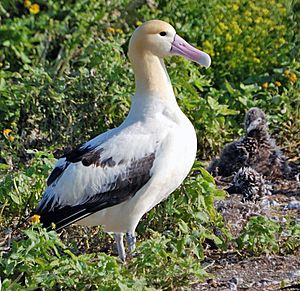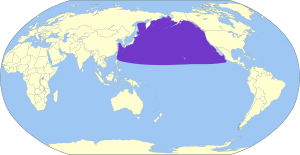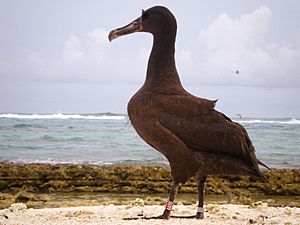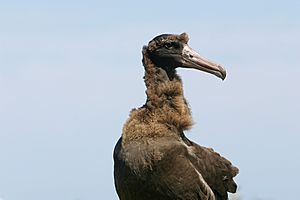Short-tailed albatross facts for kids
Quick facts for kids Short-tailed albatross |
|
|---|---|
 |
|
| Conservation status | |
| Scientific classification | |
| Genus: |
Phoebastria
|
| Species: |
albatrus
|
 |
|
| Synonyms | |
|
Diomedea albatrus |
|
The short-tailed albatross (also called Steller's albatross) is a large, rare seabird. It lives in the North Pacific. This bird is related to other albatrosses in the North Pacific. It also shares some traits with albatrosses from the Southern Ocean.
A German scientist named Peter Simon Pallas first described this bird. He used skins collected by Georg Wilhelm Steller. That's why it's sometimes called Steller's albatross. These birds were once very common. But they were hunted almost to extinction for their feathers. Thanks to protection efforts, their numbers are now growing again.
Contents
Understanding the Short-tailed Albatross
What is an Albatross?
Short-tailed albatrosses are a type of albatross. They belong to a bird family called Diomedeidae. This family is part of a larger group called Procellariiformes. This group also includes birds like shearwaters and storm petrels.
These birds have special features. They have nasal passages called naricorns on their upper bill. Albatross nostrils are on the sides of their bill. Their bills are also unique, made of seven to nine hard plates.
Special Abilities of Albatrosses
Albatrosses can make a special stomach oil. This oil is stored in their stomach. They use it to protect themselves from predators. It's also a rich food source for their chicks. Adults use it for energy during long flights.
They also have a salt gland above their nose. This gland helps them remove salt from their bodies. It's an important adaptation for living in the ocean. They drink a lot of seawater. The gland lets them get rid of extra salt through their nose.
Appearance of the Short-tailed Albatross
The short-tailed albatross is a medium-sized albatross. Its wings can spread from about 215 to 230 centimeters (85 to 91 inches). It is about 84 to 94 centimeters (33 to 37 inches) long. These birds can weigh from 4.3 to 8.5 kilograms (9.5 to 18.7 pounds).
Adult and Juvenile Plumage
Adult short-tailed albatrosses are mostly white. They have black flight feathers and some black on their tail. Their neck and the top of their head are yellowish. Their bill is large and pink. Older birds might have a blue tip on their bill.
Young albatrosses are brown all over. They slowly turn white as they get older. This change can take 10 to 20 years.
How to Identify Them
You can tell a short-tailed albatross apart from other albatrosses in its area. It is larger than the Laysan albatross and the black-footed albatross. It also has a pink bill with a bluish tip. Its feathers look different too. Even though it's called "short-tailed," its tail is not shorter than the Laysan or black-footed albatross. In fact, it's longer than the tail of the waved albatross.
Where Short-tailed Albatrosses Live
Short-tailed albatrosses now nest on four islands. Most of them nest on Torishima in Japan. Many others nest on Minami-kojima in the Senkaku Islands.
In recent years, some have started nesting in the Northwestern Hawaiian Islands. A chick hatched on Midway in 2011. Another pair began nesting on Muko-jima in Japan's Bonin Islands in 2012.
Their Travels
When they are not breeding, these birds travel across the North Pacific. Male birds and young albatrosses often gather in the Bering Sea. Females usually feed off the coasts of Japan and eastern Russia. They can also be seen as far east as California. The short-tailed albatross is listed as an endangered species in some U.S. states, like Washington.
These birds used to breed on other islands too. But they no longer do. These islands include Kita-no-shima, Enewetak Atoll, and some of the Bonin Islands.
Behaviour and Life Cycle
Feeding Habits
The short-tailed albatross mainly eats squid. They also follow ships to eat discarded offal (parts of animals).
Reproduction
Historically, these albatrosses liked to nest in large open areas. These areas were usually near patches of a grass called Miscanthus sinensis.
A short-tailed albatross usually starts breeding when it is about 10 years old. They lay one egg at a time. The egg is off-white with red spots, mostly at the wider end. It measures about 116 by 74 millimeters (4.6 by 2.9 inches). Both the male and female albatross take turns incubating the egg. This incubation period lasts for about 65 days.
Protecting the Short-tailed Albatross
| Breeding location | Population | Trend |
|---|---|---|
| Tori-shima (Izu Islands) | 3540 | up from 25 since 1954 |
| Minami-kojima and Kita-kojima | 650 | Unknown |
| Ogasawara Islands | 10 | Unknown |
| Total | 4200 |
The IUCN lists the short-tailed albatross as a vulnerable species. This means it is at risk of becoming endangered. Their total living area is huge, about 34.8 million square kilometers (13.4 million square miles). But their breeding area is very small, only about 9 square kilometers (3.5 square miles).
History of Decline and Recovery
The short-tailed albatross almost disappeared completely. They were hunted heavily for their feathers in the late 1800s. Some estimates say over 10 million birds were hunted. By the 1930s, the only known population was on Torishima island. Hunting continued there until 1933, when the Japanese government banned it. After that, the albatrosses stopped breeding on the island.
People thought the species was extinct. Then, in 1949, an American researcher visited Torishima and also thought they were gone. However, about 50 young birds survived at sea. Albatrosses take many years to become adults and return to their nesting sites. In 1954, the first egg was laid by returning birds. To help them breed, scientists placed albatross decoys on the island. This worked because albatrosses are more likely to nest if they see other birds in a group.
Current Threats and Protection
Today, the biggest threats are longline fishing and volcanic eruptions on Torishima. Other dangers include animals brought to the islands by humans, pollution, unstable soil, and extreme weather.
Many efforts are being made to protect these birds. Japan, Canada, and the United States list this bird as a protected species. Torishima is now a National Wildlife Protection Area. Native plants are being planted there to help with nesting. Also, most commercial longline fishing boats now use special devices to prevent accidentally catching albatrosses.
Short-tailed Albatross in Culture
In Japanese tradition, the short-tailed albatross is known as aho-dori. This means "idiot bird." This name comes from their habit of nesting in isolated places. This made them unafraid of predators like humans, which sadly made them easy to hunt.
See also
 In Spanish: Albatros de Steller para niños
In Spanish: Albatros de Steller para niños




